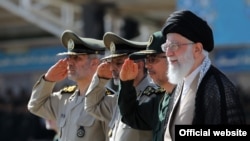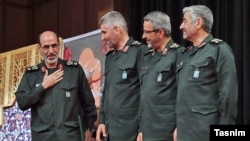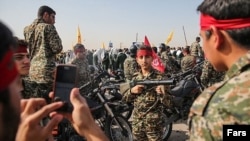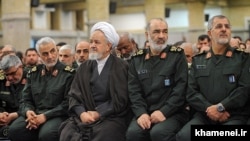Iran's Supreme Leader Ayatollah Ali Khamenei has changed some of top and middle ranking commanders of the Islamic Revolution Guards Corps (IRGC) during the past year.
The extent of and frequency of these changes among Iran's top military men have been unprecedented during the four decades since the 1979 Islamic revolution.
The changes could have been an attempt to cope with the escalation of protests against the regime, renewed activity of opposition groups, the ongoing economic crisis, as well as international pressures on Iran.
At the same time, such a mission has made IRGC the main body to safeguard the regime and ensure its survival. The implication could be further suppression of protests in Iran and creating more insecurity in the region.
Top Level Changes
In late August, Khamenei appointed Alireza Tangsiri as the commander of IRGC's naval force and moved the former commander, Ali Fadavi to the position of IRGC coordinating deputy commander. The latter was a move to introduce harmony between the IRGC military and internal security missions.
While appointing Fadavi, Khamenei mandated him with "acquiring all-out preparedness to defend the Islamic revolution and its achievements." Fadavi is an officer trusted by Khamenei and decorated by him for detaining US marines in the Persian Gulf in 2016.
Two months before the two appointments, IRGC commander Mohamad Ali Jafari selected Brigadier General Jamaleddin Abroumand as his deputy at the Soft War Headquarters. This was a major promotion that made the headquarters more important.
In March, Jafari appointed IRGC General Mohamad Hossein Sepehr as deputy chief of the Basij militia, an organization specialized in controlling large gatherings and suppressing protests. While introducing him, Jafari highlighted the fact that "As the revolution turns 40, the enemies are trying hard to target it…and there are problems in the country that we need to solve." This was an elaborate reference to major demonstrations that shook more than 100 Iranian cities some eight weeks before Sepehr's appointment.
Meanwhile, a few weeks before that, Khamenei replaced his representative at the IRGC with a more hardliner cleric, Abdollah Hajisadeqi.
Changes At Provincial Level
The same kind of change also took place at the provincial level, particularly in the strategically important Tehran Province. A new commander was appointed for the Tehran Province IRGC, aka Seyyedalshohada Corps, but was soon replaced by an even more loyal officer, Brigadier Hassan Hassanzadeh in October.
The Greater Tehran IRGC, aka Mohammad Rasoulallah Corps, the main IRGC force in charge of the capital's security also underwent changes as Khamenei was not happy with IRGC's performance during widespread demonstrations in December 2017 and January 2018.
The IRGC security forces had already been reinforced and their commanders changed following the 2017 ISIS attack on the Iranian Parliament. In a structural change, two different forces were separately mandated to keep Tehran secure against attacks and protests. One of these commanders, Esmail Kosari who had served as an MP for two rounds, is well known as a top security official rather than a military commander.
Meanwhile, a new commander was appointed for Khatam ol-Anbia HQ, the IRGC's financial conglomerate. Mohamad Saeed, 50, has been with IRGC for over 30 years before taking over the force's economic behemoth.
From Strait of Hormuz To Street Protests
The widespread changes in IRGC's command are meaningful and significant. Generally, strictly controlled regimes such as the Islamic Republic of Iran keep rotating commanders between geographical locations in a bid to prevent alliances among officers that could be instrumental in any coup attempt.
It appears that Khamenei and his top security men have put IRGC in charge of the country's security. On the other hand, the officers who have been replaced with new commanders have had unusually long service records, serving between 6 to 12 years each at their last position.
International sanctions, the US pull-out from the nuclear deal with Iran and the Trump administration's seriousness in confronting Iran could have been part of the reason why changes have been made. At the same time, frequent protests in Iran have increased fears about the decline in the regime's legitimacy and ability to control the population.
This clear and present danger, coupled with the implication of a fragile economy must have led Khamenei to appoint more loyal, hardliner and fresh commanders, with more interest in security than military affairs, at the core of the country's armed forces.
On the military side, new hardliner commanders such as Tangsiri, who is very well known for his anti-US stance, have sworn to take part in suicide missions against U.S. forces. This is a commander IRGC Navy needs when threatening to shut down the strait of Hormuz. "If the time comes, there are men wrapped in explosives who would hit themselves against US warships," Tangsiri has been quoted as saying.
It appears that the IRGC is now the main force to safeguard the regime and ensure its survival. The implication, could be further suppression of protests in Iran and creating further insecurity in the region.











